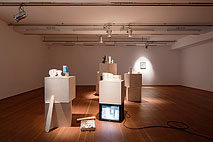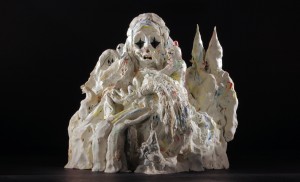I was reading articles about Art Basel and found Zin Taylor, and immediately thought about the conversation we had about “art thats about art”. I think he serves as a pretty good example of this type of work:



I was reading articles about Art Basel and found Zin Taylor, and immediately thought about the conversation we had about “art thats about art”. I think he serves as a pretty good example of this type of work:



Before anything, I need to settle on the sounds I want the speakers to play. I tried to think of the sensation I wanted people to feel when walking through this tunnel of fabric. I don’t want to recreate an existing atmosphere, I want to let people experience an atmosphere they have never experienced before. While browsing through ambient sounds in youtube, I ran into a video 10 Hours Rainfall. It’s a video playing sounds of rainfall for 10 hours. I thought it would be unusual for people to experience a rainfall in a dry setting. They would be just hearing but not actually feeling the rainfall.
In terms of dyeing the fabric, I think I will use the Shibori dyeing technique. Here are some images done in Shibori teachnique.
Or I might end up doing the simple dyeing technique. Much like the image below.
Some of the dyeing techniques used for the textile used for a runway show also seems to create a beautiful atmosphere.
I would like to go in a direction towards a claymation animation for my final project. While researching artists working in this medium, I came across some really amazing work by Allison Schulnik. The movement in the clay reminds me a bit of ‘Baby Snakes’.
Here is her website, she also does painting and sculpture work:
http://www.allisonschulnik.com/#
Below are some screenshots from her films:


For the final project, I’m planning on continuing my studies on fabric speakers. I looked at several artists for visual and conceptual inspiration. Janet Cardiff recently did a project called Forest where she installed more than 30 speakers in a forest, each speaker emitting “near synchronicity of natural or mediated sounds” (Gregory Volk).
I also looked at David Tudor’s Rainforest collection. This music collection was of “endangered” sounds we would hear in rainforest. It is said that “the result is a timeless sonic environment full of rech textures offering the listener an infinite variety of aural densities and spatial effects. Intensely alive and unlimited” (mode 64).
It seems that to distinguish this fabric speaker as an art piece, having a conceptual idea would be very important. Otherwise, it would just become another form of speaker. I thought about what kind of sound I would want the speakers to make. I think it would be smart to play sounds that would add to the characteristics of the fabric speaker, which is soft and small. Like whispers of sound and music.
Visually, I’ve been inspired by Christo and Jeanne-Claude’s The Gates piece. The color, texture, and the instillation seemed visually so beautiful.
I’ve also looked at Robin Minard‘s works. His work is the most closely related to mine where he installed vines of speakers on the wall. His work somewhat imitates how ivy would grow on the walls. Visually, I thought his work was also simple yet captivating.
http://emilykatz.virb.com/embroideries
Really really beautiful embroidered illustrations.
Does work on several types of fabrics and also embroiders material like paper, which allows her to incorporate watercolors and other materials not as suited for fabric pieces.
This artist has a really cool process for his embroidery works:
He “unworks” cross-stitch samplers, and then re-works the ground fabric in the same number of stitches and colors as the original composition (a ghostly outline remains).
http://www.briangrossfineart.com/exhibitions/ssollins05.html
I really appreciate both the aesthetic and the process of his work.
A couple artists using fabric and sewing:

For some straight up lovely embroidery: Allison Watkins. Love the slight irony of embroidering images of fabric onto fabric, as well as just the aesthetics of this (thin, tenuous linework, etc.)
A slightly more process based artist using fabric: Ilysia Van Deren

She did a whole series of these handkerchiefs. Her statement is as follows:
How-To documents the process of ripping and re-sewing vintage handkerchiefs by hand, sometimes repeatedly. The projected video exposes a neurotic, obsessive process that is simultaneously mesmerizing and unsettling. The process acts as a means of releasing internalized experiences and frustrations, making the modification of each piece of fabric a uniquely personal and cathartic act. The hyper-detailed scanned images act as a document of the destruction; each fiber, tear and sloppy stitch on display for examination. Forever altered, these objects take on new identities. The act of repair becomes an integral part of a continuous cycle of destruction and reconstruction, of tearing down and building up.
Super into how process based this is, and the idea of destruction as construction (currently a Very Relevant Theme in my work)
There is also a video piece that goes with it:
How-To from Ilysia Van Deren on Vimeo.
Also a fan of this series by her:
